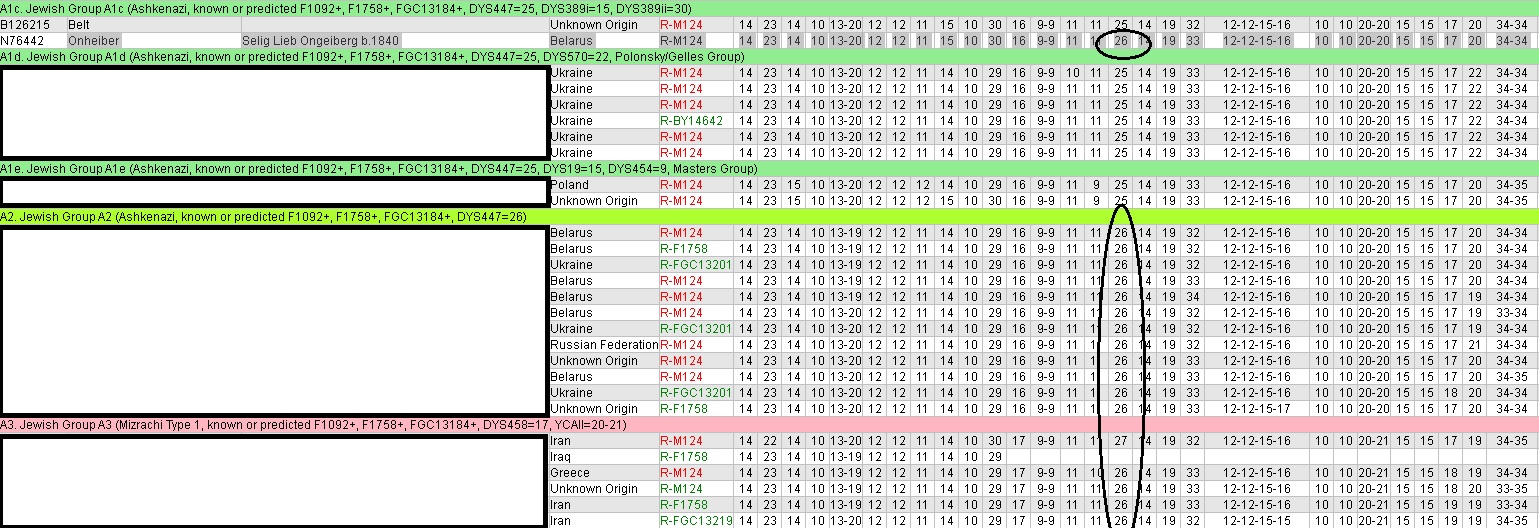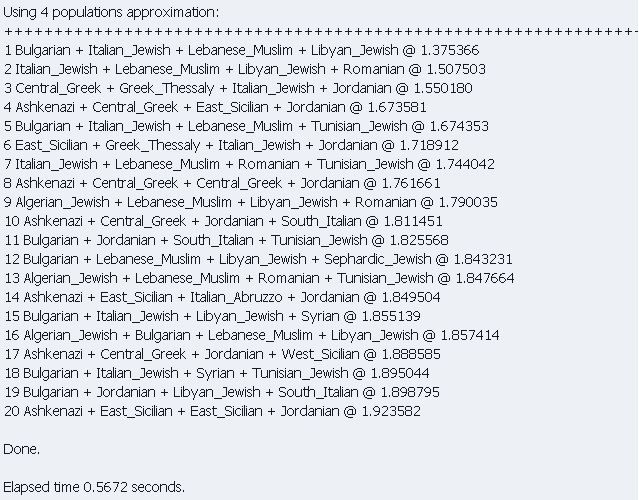Onheiber is not a common name.
My paternal grandfather, an Ashkenazi immigrant from Belarus, had to standardize the American spelling of this goofy last name himself.
This makes genealogy really hard. So, I turned to Y-DNA testing in an attempt to identify our roots and pinpoint our origins beyond the borders of Belarus. Our results were strange.
We were truly fortunate to discover a patrilineal DNA connection with Dr. Jeffrey Mark Paull–co-founder of FTDNA’S Jewish R-M124 Project, author of A Noble Heritage: The History and Legacy of the Polonsky and Paull Family in America, and Academia.org genealogy expert–without whose help this blog would not have been possible.
Dr. Paull, a haplogroup R-M124 cousin, pieced together essential parts of a historic journey across time and space while circumventing the typically frustrating limitations of traditional genealogy using y-DNA.
“ The lack of Jewish surnames, combined with the widespread destruction of Jewish records and tombstones, can greatly hinder genealogical research, often rendering it virtually impossible. But for those fortunate individuals who can establish descent from one or more of the great rabbinical families, there exists a treasure trove of genealogical information.”
The following information is based on my brother’s Y-37 FTDNA kit which only cost about $150. However, more comprehensive testing is available that can further elucidate subgroups and help advance science as new subclades are identified and added to the human phylogenetic tree. Only males can take this particular type of test. You can purchase yours from FTDNA here. I would STRONGLY URGE anyone bearing haplogroup R-M124 to purchase a Big Y Kit.
If you tested with 23andMe, please note that their outdated phylotree places R-M124 individuals into the parental R-M479 group from which R-M124 is derived. This happens to 23andMe customers if they belong to a rare haplogroup such as y-DNA R-M124 or mtDNA X1c because the phylotrees at 23andme are ridiculously outdated. However, because the number of affected customers is so small in instances of these rare haplogroups, there is little reason for them to update their entire database.
Distribution
This was a weird result to get, particularly because it isn’t associated with European populations or, usually, Jews at all.
Only about 1% of Jewish men who take y-DNA tests belong to this haplogroup–that’s 1% of a .2% global population decimated by the holocaust.
That’s not a lot of samples.
The vast majority of R-M124–also known as R2a– men actually reside in South Asia, in places like Pakistan and northwestern India where the Sinti Romani people originate. It’s rare for Ashkenazi to test as R-M124.
Romani would have been easier to believe than a connection to the Babylonian Captivity, Persian empire, and even Esther of the Bible.
Theories on European Presence
“In our case, the temptation is to say that our family was from Russia because that is the last place they lived before immigrating to America. But Russia was merely the last stop in a millennial journey that took our ancestors across nearly the entire continent of Europe, and historically speaking, it was not a particularly lengthy stop at that”.
A Noble Heritage: The History and Legacy of the Polonsky and Paull Family in America, p. 31
There are a few different scenarios that might reasonably explain haplogroup R-M124’s presence in Europe, and they are not necessarily mutually exclusive.
- Persian armies containing R-M124 men marched on Babylon, coming into contact with captives from the Jewish Diaspora
- Babylonians settling in eastern Khazaria or Narbonne, France after scholars and Rabbis were invited to their centers of learning to instruct new converts
- Scattering and fleeing refugees from Islamic/Muslim rule and Mongol hordes migrated directly into Eastern Europe from the Caucausus/Central Asia
All three of these scenarios may be true. We’ll need a more in-depth y-DNA test to show exactly how our markers fit into the larger picture.
“Jewish men in haplogroup R-M124 usually (but not always) have an Ashkenazi family history. However, they are genetically very similar to people whose ancestors lived in the ancient Babylonian and Persian empires (known today as Iraq and Iran).”
1500 Years Ago…..
R-M124 men migrated west into Persia from their South Asian origin where they likely became absorbed into the population and marched in Persian armies.
“In Biblical times, Persian armies, probably including R-M124 men, went even further west under Cyrus the Great and conquered ancient Babylonia, where Persians came in contact with the Jewish Babylonian populace that had been exiled as captives after the destruction of the First Temple in Jerusalem in 586 BCE…”

The Assyrians had long dominated the Middle East, but their power was waning. Even with the help of the Egyptians, who were getting stronger, they were not able to fight off the Babylonians. These three empires were engaged in a power struggle, and the Kingdom of Judah was caught in the middle.
In 434 BCE, the Kingdom of Judah tried to form an alliance with Egypt. The Jews thought, despite Jeremiah’s prophecies, that this would keep them safe. But instead, the Babylonian king, Nebuchadnezzar, marched on Judah. He pillaged Jerusalem and deported tens of thousands of Jews to his capital in Babylon; all the deportees were drawn from the upper classes, the wealthy, and craftsmen. Ordinary people were allowed to stay in Judah, and Nebuchadnezzar appointed a puppet king over Judah, Zedekiah. —The Destruction of The First Holy Temple, Chabad.org
The Book of Esther comes to mind, the story of a Persian Emperor — usually associated with Xerxes (Ahasuerus) — taking a Jewish wife.
The Book of Esther is notable for the lack of divine intervention or supernatural occurrences. Instead, it revolves around political upheaval, diplomacy, attempted genocide, and wifey material. Check it out on Netflix!

1,000 years ago
Subgroup A1 splits off from A2 with a deletion at DYS447.
Historical migrations brought rabbis and teachers to centers of learning in Khazaria around 1,000 years ago. Descendants of these immigrants could be present in Central Asia’s Mountain Jew communities of Azerbaijan and Dagestan–where up to 16% of men tested belong to haplogroup R-M124–or have traveled further entering Lithuania where Jews have been present since at least the 8th century.
“While the origin of these eastern Jews is not certain, historical evidence places Jewish refugees from Babylonia, Palestine, the Byzantine Empire and other Jewish refugees and settlers in the lands between the Baltic and Black Seas that would become part of the Grand Duchy of Lithuania.”
It is also possible that the long-standing Jewish community in Narbonne, France welcomed similar resettling Babylonian scholars and families.
More modern migration scenarios might be Mizrachi Jewish families seeking refuge in foreign lands to escape from persecutions in Islamic occupied Babylonia and the Mongol and Muslim dynasties of Persia”
Subclades A3..A2..A1…blastoff!!
The date of divergence between the A3 and A1+2 lines depends heavily on the number of test-takers involved. If any male Onheibers are reading this, PLEASE GET TESTED! This is not the Ancestry.com Autosomal DNA test, this is specifically for the paternal line and the tests are purchased from FamilyTreeDNA.Com
A3 is the oldest subgroup and remains characterized by the modern Mizrahi communities in Iran and Iraq, much as it did millennia ago.
Ashkenazi R-M124 males belong to groups A1 and A2, which branched off from our A3 origin 1000-1500 years ago.
European Jews then further diverged as a unique mutation developed differentiating between the two closely-related groups of A2 and A1.
My brother’s results indicate he is a descendant of one of these new mutations in group A1 called A1c, which did not exist yet in the older A2 and A3 populations. Only one other member of FTDNA’s Jewish R-M124 Haplogroup Project is identified as a subgroup member with us. I’m not sure what to make of this, to be quite frank. But that’s the data. Check it out. We are shown in blue.


500 years ago….
Expulsion from Spain, Genetic Distance and making connections with TiP reports.
FTDNA offers a y-match analysis tool called Time Predictor (or TiP), described as being a “powerful and precise calculations of time to common ancestor estimates by incorporating mutation rates specific to each STR marker.”
I use this tool to identify which matches are closer to me than others at the same genetic distance. This is a useful tool because some markers mutate faster than others.
Disparities within TiP reports for matches with the same genetic distance is like a smoking gun AND ROCKET FUEL TO ME! Woot.
300-400 Years ago: Before Belarus
Since the R-M124 haplogroup is so rare in Ashkenazim, we were very fortunate to discover a leading R-M124 researcher among our matches: Dr. Jeffrey Mark Paull.
According to Dr. Paull’s research and FTDNA’s TiP report, he suggests our common ancestor could have been the unknown grandfather of Rabbi Moses Gelles–known as Menachem Mendel Levush until his marriage when he took his wife’s surname Gelles. This unknown shared ancestor lived sometime between 300-400 years ago.
Dr. Paull is co-administer of the Jewish R-M124 project on FTDNA, author of R-M124 case study Connecting To The Great Rabbinic Families Through Y-DNA, and author of the book A Noble Heritage. Chapters from this book are available for download here.
Ashkenazi, Sephardic, Mizrahi, Oh My!
I was surprised to learn through DNA testing my Ashkenazi family had some strong Sephardic signals through GEDmatch’s Eurogenes EUtest V2 k15 4-population oracle.
Once I did a little research, I learned the historical migration patterns of Jews across Europe have left their mark on many modern-day Ashkenazi testers, and Sephardic heritage among Ashkenazi is actually quite common.

“Elizabeth, your K36 result is not easily identifiable as recently ‘modal’ Ashkenazi (low Arabian, low East Med, low Near East etc), and not easily identifiable as ‘Eastern Jewish’ (aka Mizrachi) but is definitely characteristic of ancestral Sephardi…Accepting that your ancestor’s Mizrachi inherited YDNA was an ancient inheritance does mean that it would be unlikely that remnants of that ancient origin would be retained to the present day in autosomal DNA. So the dearth of Mizrachi K36 results are not surprising. One logical hypothesis, is that your Mizrachi ancestor was one of those who came from the Sura or Pumbeditha to a seat of Sephardi learning in the 11th or 12th century – these incidents are recorded. They would then have retained a Mizrachi YDNA but the aDNA would – after such a long period – show as distant Sephardi with potentially a recent ‘Ashkenazi’ input.” Jews of Tzarfat, Ashkenaz and Sepharad: Best calculator for Mizrahi ancestry?
These signals of Sephardic origin on autosomal DNA tests in conjunction with our Mizrahi haplogroup really illustrates exactly how this population has migrated over millennia.
References
Jews of Tzarfat, Ashkenaz and Sepharad: Best calculator for Mizrahi ancestry?
Connecting to the Great Rabbinic Families Through Y-DNA: A Case Study of the Polonsky Rabbinical Lineage. AVOTAYNU: The International Review of Jewish Genealogy,XXIX(3), Fall 2013, 17-24.
A Noble Heritage: The History and Legacy of the Polonsky and Paull Family in America
Rabbi Mordechai Jaffe (The Levush)

